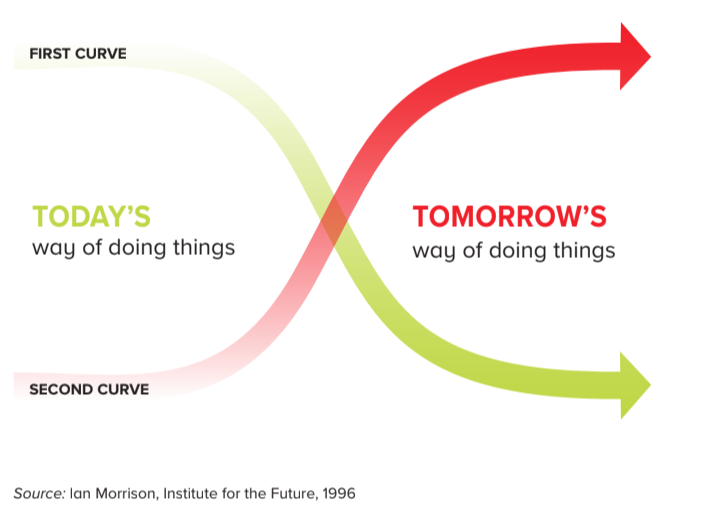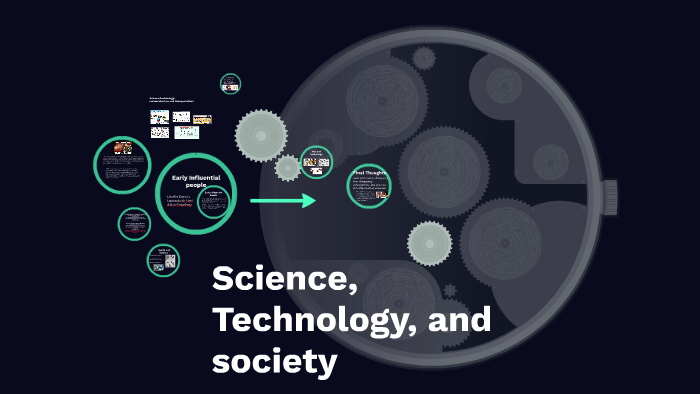Intuitively we understand that there is an interconnectedness between science, technology, and society. However, most of us fail to have a deeper understanding of the role of science and technology in driving waves of societal transformation. Hence, we look for predictions–based on past data–at the time of massive transformation. However, we invariably observe those predictions to fail. Subsequently, we come up with the conclusion that transformation is taking place due to the magical power of heroic creative genii. Such reality demands us to have a smarter perspective.
It seems that nobody can predict massive socio-technical transformations. But that matters to us. Those transformations will change the market value of knowledge, skills, jobs, materials, and many of the products we use today. But what about data and data analytics tools. Unfortunately, the future does not have data. Hence, predictions based on past data invariably deviate from reality, particularly at the moment of discontinuity. To have the foresight that matters for deriving insights for taking long-term decisions, we should focus on comprehending big, complex transformations. Therefore, we should be looking at the interconnection between science, technology, and society, and also economics and organizations.
Massive transformation occurs due to two waves
Transformational change is often painful. We have been living on the current wave. Of course, it changes; but at a slow space. These small changes are like wavelets. For example, the car’s next model shows up with a couple of added features and the advancement of a few existing ones. Hence, passengers and drivers need minor adjustments. Maintenance technicians also need slight skill upgradation. As changes are incremental, that does not appear to be difficult to cope up with. But what about the car that shows up without an internal combustion engine or that drives itself. These changes are not wavelets. Instead, it’s the beginning of a new tide, megatrend, or a large wave. That wave would drive transformation. It will make the supply chain, jobs, rules, and regulations of the current wave obsolete. The interconnectedness of science, technology, and society is the underpinning of such waves of change.
Coincidentally, this two-wave phenomenon in explaining the transformation of society fits very well within the Unified Theory of Innovation. It also integrates Technology and Innovation management issues well within the context of the broader issue of the transformation of society.

Underlying factors for growing height, wider swath, and the rapid rise of waves of transformation
In the preindustrial stage, our ancestors’ knowledge was in the art form. Thus, inventions, as well as innovations, appeared as makeshift solutions—as the outcome of the intuition-based tinkering approach. They were not scalable. Hence, they grew as wavelets as opposed to waves. However, it started changing due to our progress in transferring the art form of knowledge into science. Hence, makeshift solutions started finding the path of being scalable—forming waves. Consequentially, the first wave we observed was the one due to the steam engine–during the first industrial revolution. We also observed such transformational waves during the second and third industrial revolutions.
We have also been observing that waves during subsequent industrial evolutions are getting larger as well as faster. The underlying factor appears to be that the growing use of scientific knowledge has been making inventions and innovations increasingly scalable—also at a faster rate. Hence, transformational implications are leaving deeper and broader impacts while giving us a decreasing amount of time to respond. Moreover, the availability of venture capital finance to rapidly scale up is also contributing to such waves of transformation. Hence, we should carefully look into the interdependence between science, technology, and society to detect signals, develop foreignness, and draw insights for taking action.
Discontinuity occurs at the intersection of two Waves—demanding us to focus on interdependence between science, technology, and society
As long as we are living on the same of the same wave, changes are incremental. Historical data provide enough insights to predict likely changes occurring over the next one or three years. Moreover, prediction about such change does not matter much as the intuitive adjustment is good enough. However, during the period when the current wave starts declining due to the next wave’s uprising, discontinuity is created. At this point, all predictions model based on data starts showing deviation, at a wide margin, from the unfolding reality. Consequentially, we become helpless to decide. The transformation appears to be the outcome of heroic acts of innovators, making all of us clueless. Fortunately, we have some references to look into to understand the underlying dynamics.
The present state of society is the outcome of the current state of a number of waves. Each of those waves is offering us means of serving our purposes. For example, the present state of the automobile industry wave determines the way we make, buy, own, operate, and maintain automobiles to serve our transportation purpose. The current state is far different than the one our previous generation had, say 120 years ago. For example, instead of breeding and feeding horses to propel wagons, we explore oil fields, develop potential deposits, pump, transport, and refine crude oil, and fuel automobiles at the gas stations. Hence, there has been wide variation in the market value of natural resources, knowledge, skills and jobs, and investment prospects between these two eras.
At the maturity of the underlying technology cores, discontinuity shows up
Each wave driving our society is powered by technologies. In addition to the core ones, there are also numerous complimentary ones. For example, for the automobile, we have two technology cores. The first one is the way we propel them, and the second is about the way we drive. Irrespective of the greatness, each of the technology core matures, slowing down further advancement. To overcome this limitation, we explore science and invent alternative technologies. Often at the maturity of the current wave, we find enough incentives to allocate resources to discover science and pursue emerging technologies.
For example, both the two technology cores of automobiles have been showing signs of maturity for a long. On the one hand, the growth of internal combustion engine technology has been failing to meet our expectations of efficiency improvement and emission reduction. On the other hand, human drivers’ limitation has reached an alarming state. It is the root cause of more than 1.3 million deaths per year due to road accidents, involving automobiles. Hence, we badly need alternatives to these technologies.
Fortunately, scientific progression has led to renewable energy, fuel cell, and battery technologies. Furthermore, the growth of sensors, software, image processing, mapping, data analytics, pattern recognition, and connectivity technologies have been showing the possibility of developing a technology core for making automobiles driverless. Hence, we have reached a point of the decline of the current wave’s attractiveness and the rising of the next one. At this intersection, we face discontinuity. Hence, the prediction of change based on past data fails to anticipate the rate of change.
At the discontinuity, the interconnectedness between science, technology, and society offers foresight
At this point of intersection of two waves, understanding the likely unfolding future is far more important than ever before. From this point forward, the future will look far different than the past. Our rules and regulations guiding the current wave will no longer be suitable for the next wave. Similarly, knowledge, skills, and jobs for adding value during the next wave will be quite different than the past. Due to past data-based prediction’s failure, the unfolding reality appears to many of us as the magical show of innovators’ heroic acts.
However, science offers us the clue to developing foresight of the transformation. By the way, foresight is not about numeric predictions. Instead, it refers to a plausible internally consistent view of the future. Often, such a view is good enough to be on the right side during the unfolding of mega transformation. In fact, the rising of the emerging wave is mostly dictated by the underlying science, fueling the invention and innovation. For example, at what rate electric vehicles will take over existing gasoline vehicles depends on the science of powering battery or fuel cell technologies. Innovators must make progress in storing far more electrical energy is far less material to make the electric vehicle a better and cheaper alternative to the current wave.
Hence, to have foresight, we should look into the progression of scientific discoveries for helping us improve technologies or invent better technologies. This foresight will help us to better comprehend the speed of the unfolding of the next wave. Moreover, it will also help us determine whether this new wave will grow to take over the current wave or not. Therefore, we should focus on science and its implication on technology progression, affecting the profitable exploitation of innovations—subsequently, driving the next wave.
Science, technology, and society—an interconnected phenomenon of transformation
Transformation of the Society due to the decline of the current wave and the rising of the emerging one is not a random phenomenon. On the other hand, past data analysis does not offer us foresight about the unfolding reality. It’s also not due to a magical show of heroic act of creative genius either. In fact, science drives technology, which creates a profitable business opportunity for innovators to pursue alternatives. Instead of the magical power of creative genius, the underlying science determines the scale, scope, and speed of the next wave’s emergence.
For example, the silicon revolution forming Silicon Valley is not due to the act of a few creative genii or Moore’s law only. At the surface, to many of us, that appears to be the truth. Instead, this is due to the fact that Silicon was highly amenable to producing increasingly smaller and better transistors. Scientists have been excavating in discovering scientific principles and transferring them into more precise design and processing technologies. If science had not permitted, the scale, scope, and speed of uprising of the Silicon economy could have been far different.
In fact, this is one of the reasons that the success of Silicon Valley is hard to replicate. So instead of Moore’s law, it is more appropriate that we call it Silicon Law. Therefore, we should keep watching the interconnectedness between science, technology, and society. It will lead to having better foresight for empowering us to make smarter decisions, particularly at the intersection of two waves.




